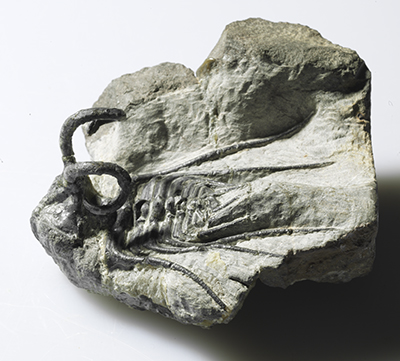March 2024: Trilobite, Dicranurus monstrosus
(BARRANDE 1952)
Middle Devonian, approx. 390 million years old, Tabouright near Alnif, southern Morocco; dimensions of the fossil: length 8 cm height: 2 cm width: 6 cm
For almost 270 million years, the prehistoric seas were inhabited by mostly small but diverse and sometimes bizarre creatures. Trilobites (ancient Greek: τρία tria = “three” and λοβός lobós = “lobes”) are an extinct group of arthropods, which also includes insects. Like all arthropods, they are divided into unequal body sections, have paired articulated extremities, an outer skeleton (dorsal armor) made of chitin, usually with calcium deposits, and grow through repeated molting. The trilobites owe their name to their horizontal and vertical tripartition. The first trilobites appeared around 521 million years ago (Cambrian) and were therefore the most advanced life forms at that time. They were able to survive until the mass extinction event at the end of the Permian (approx. 252 million years ago). Many representatives are important index fossils.
All trilobites were egg-laying sea dwellers, but tracks or feeding traces indicate that they were also able to move on land, at least for a short time. They were perfectly adapted to all marine habitats. Their way of life can be deduced from the size of their eyes and the morphology of their tail shield: For example, trilobites living in the substrate are usually eyeless with a smooth tail shield, whereas swimming representatives usually have large eyes and a large tail shield. Trilobites have so-called compound eyes, which consist of up to several hundred individual eyes. The internal structure of the compound eyes corresponds to that of modern crustaceans, insects and millipedes. It was not until 2023 that it was proven that trilobites also had 3 median eyes (individual eyes on the forehead) between the two compound eyes, like today’s crustaceans and insects.
Their biggest predators were probably fish, sea scorpions and large squid, from which they could protect themselves by curling up their bodies. In addition, many species formed impressive armoring from spine-like projections on their carapace. A bite into these spines must have been very unpleasant for the attacker. This development apparently reached its peak in the Devonian, as the genus Dicranurus CONRAD 1841 impressively demonstrates. Dicranurus’ monstrous appearance even inspired the designers of the alien monster from the 2012 film Prometheus.
The name Dicranurus monstrosus comes from the Greek (dikranon + oura) and roughly means monstrous pitchfork tail. The eponym of the genus (CONRAD) mistook the type fossil of Dicranurus, which consisted only of a head shield, for a complete individual and therefore interpreted the horns as a tail. The mouthparts of D. monstrosus indicate that it was an epibenthic predator that probably fed on worms. The species was initially described by BARRANDE in 1852 under the name Acidaspis monstrosa, but was later assigned to the genus Dicranurus, whose representatives today can – among other places – be found in Oklahoma, New York and Morocco. This corresponds to the former shallow sea areas between Euramerica and Gondwana (Rheic Ocean). Morocco is world-famous for its exquisitely preserved and often unique trilobites. More than 400 Moroccan species have already been described from the Devonian alone.
Melanie Altner, München

Dicranurus monstrosus

Dicranurus monstrosus



